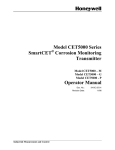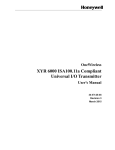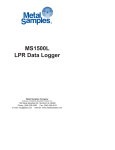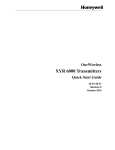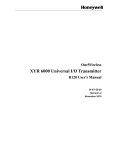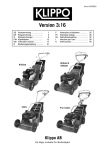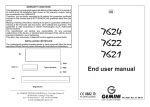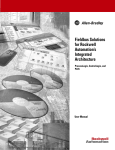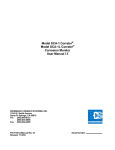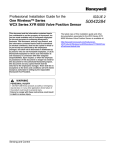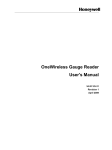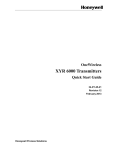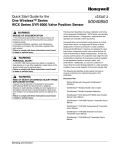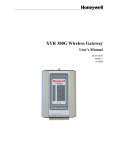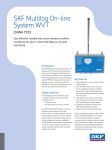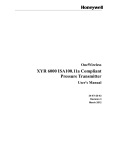Download XYR 6000 SmartCET Corrosion Transmitter
Transcript
OneWireless XYR 6000 SmartCET Corrosion Transmitter User's Manual 34-XY-25-18 R100 6/7/07 Release 100 Notices and Trademarks Copyright 2007 by Honeywell International Inc. Release 100 June 7, 2007 While this information is presented in good faith and believed to be accurate, Honeywell disclaims the implied warranties of merchantability and fitness for a particular purpose and makes no express warranties except as may be stated in its written agreement with and for its customers. In no event is Honeywell liable to anyone for any indirect, special or consequential damages. The information and specifications in this document are subject to change without notice. Honeywell, PlantScape, Experion PKS, and TotalPlant are registered trademarks of Honeywell International Inc. Other brand or product names are trademarks of their respective owners. Honeywell International Process Solutions 2500 West Union Hills Phoenix, AZ 85027 1-800 343-0228 ii OneWireless XYR 6000 SmartCET Corrosion Transmitter User's Manual R100 6/7/07 About This Document This document describes preparation, operation and maintenance of the XYR 6000 Wireless Corrosion Transmitters. Mounting, installation and wiring are covered in other documents. Honeywell does not recommend using devices for critical control where there is a single point of failure or where single points of failure result in unsafe conditions. The initial release of OneWireless (R100) is targeted at open loop control, supervisory control, and controls that do not have environmental or safety consequences. As with any process control solution, the end-user must weigh the risks and benefits to determine if the products used are the right match for the application based on security, safety, and performance. Additionally, it is up to the end-user to ensure that the control strategy sheds to a safe operating condition if any crucial segment of the control solution fails. Release Information Document Name XYR 6000 SmartCET Corrosion Transmitter User's Manual Document ID Release Number Publication Date 34-XY-25-18 100 6/7/07 References The following list identifies all documents that may be sources of reference for material discussed in this publication. Document Title XYR 6000 Transmitters Quick Start Guide Getting Started with Honeywell OneWireless Solutions OneWireless Wireless Builder User’s Guide OneWireless Builder Parameter Reference Support and contact info United States and Canada Contact: Honeywell Solution Support Center Phone: 1-800 822-7673. In Arizona: 602- 313-5558 Calls are answered by dispatcher between 6:00 am and 4:00 pm Mountain Standard Time. Emergency calls outside normal working hours are received by an answering service and returned within one hour. Facsimile: (602) 313-3293 Mail: Honeywell TAC, MS P13 2500 West Union Hills Drive Phoenix, AZ, 85027 R100 6/7/07 OneWireless XYR 6000 SmartCET Corrosion Transmitter User's Manual iii Europe Contact: Phone: Facsimile: Mail: Honeywell TAC-EMEA +32-2-728-2732 +32-2-728-2696 TAC-BE02 Hermes Plaza Hermeslaan, 1H B-1831 Diegem, Belgium Contact: Phone: Honeywell Global TAC – Pacific 1300-300-4822 (toll free within Australia) +61-8-9362-9559 (outside Australia) +61-8-9362-9564 Honeywell Limited Australia 5 Kitchener Way Burswood 6100, Western Australia [email protected] Pacific Facsimile: Mail: Email: India Contact: Phone: Facsimile: Mail: Email: Honeywell Global TAC – India +91-20- 6603-9400 +91-20- 6603-9800 Honeywell Automation India Ltd. 56 and 57, Hadapsar Industrial Estate Hadapsar, Pune –411 013, India [email protected] Korea Contact: Phone: Facsimile: Mail: Email: Honeywell Global TAC – Korea +82-2-799-6317 +82-11-9227-6324 +82-2-792-9015 Honeywell Co., Ltd 17F, Kikje Center B/D, 191, Hangangro-2Ga Yongsan-gu, Seoul, 140-702, Korea [email protected] People’s Republic of China Contact: Honeywell Global TAC – China Phone: +86- 21-5257-4568 Mail: Honeywell (China) Co., Ltd 33/F, Tower A, City Center, 100 Zunyi Rd. Shanghai 200051, People’s Republic of China Email: [email protected] iv OneWireless XYR 6000 SmartCET Corrosion Transmitter User's Manual R100 6/7/07 Singapore Contact: Phone: Facsimile: Mail: Email: Honeywell Global TAC – South East Asia +65-6580-3500 +65-6580-3501 +65-6445-3033 Honeywell Private Limited Honeywell Building 17, Changi Business Park Central 1 Singapore 486073 [email protected] Taiwan Contact: Phone: Facsimile: Mail: Email: Honeywell Global TAC – Taiwan +886- 7- 536-2567 +886-7-536-2039 Honeywell Taiwan Ltd. 17F-1, No. 260, Jhongshan 2nd Road. Cianjhen District Kaohsiung, Taiwan, ROC [email protected] Japan Contact: Phone: Facsimile: Mail: Email: Honeywell Global TAC – Japan +81-3-6730-7160 +81-3-6730-7228 Honeywell Japan Inc. New Pier Takeshiba, South Tower Building, 20th Floor, 1-16-1 Kaigan, Minato-ku, Tokyo 105-0022, Japan [email protected] World Wide Web Honeywell Solution Support Online: http://www.honeywell.com/ps Elsewhere Call your nearest Honeywell office. Training Classes Honeywell Automation College: http://www.automationcollege.com R100 6/7/07 OneWireless XYR 6000 SmartCET Corrosion Transmitter User's Manual v Symbol Definitions The following table lists those symbols used in this document to denote certain conditions. Symbol Definition ATTENTION: Identifies information that requires special consideration. TIP: Identifies advice or hints for the user, often in terms of performing a task. CAUTION Indicates a situation which, if not avoided, may result in equipment or work (data) on the system being damaged or lost, or may result in the inability to properly operate the process. CAUTION: Indicates a potentially hazardous situation which, if not avoided, may result in minor or moderate injury. It may also be used to alert against unsafe practices. CAUTION symbol on the equipment refers the user to the product manual for additional information. The symbol appears next to required information in the manual. WARNING: Indicates a potentially hazardous situation, which, if not avoided, could result in serious injury or death. WARNING symbol on the equipment refers the user to the product manual for additional information. The symbol appears next to required information in the manual. WARNING, Risk of electrical shock: Potential shock hazard where HAZARDOUS LIVE voltages greater than 30 Vrms, 42.4 Vpeak, or 60 VDC may be accessible. ESD HAZARD: Danger of an electro-static discharge to which equipment may be sensitive. Observe precautions for handling electrostatic sensitive devices. Protective Earth (PE) terminal: Provided for connection of the protective earth (green or green/yellow) supply system conductor. Functional earth terminal: Used for non-safety purposes such as noise immunity improvement. NOTE: This connection shall be bonded to Protective Earth at the source of supply in accordance with national local electrical code requirements. Earth Ground: Functional earth connection. NOTE: This connection shall be bonded to Protective Earth at the source of supply in accordance with national and local electrical code requirements. Chassis Ground: Identifies a connection to the chassis or frame of the equipment shall be bonded to Protective Earth at the source of supply in accordance with national and local electrical code requirements. vi OneWireless XYR 6000 SmartCET Corrosion Transmitter User's Manual R100 6/7/07 Contents 1. INTRODUCTION .................................................................................................... 1 1.1 Purpose ..........................................................................................................................................1 1.2 Scope..............................................................................................................................................1 1.3 OneWireless network overview ...................................................................................................1 1.4 About the transmitter....................................................................................................................1 2. SPECIFICATIONS ................................................................................................. 3 2.1 Certifications and approvals........................................................................................................3 Transmitter .............................................................................................................................................................3 Authentication Device.............................................................................................................................................3 2.2 Probes ............................................................................................................................................4 Electrode area ........................................................................................................................................................4 Constants for common probe materials..................................................................................................................4 3. PREPARATION ..................................................................................................... 6 3.1 Installation .....................................................................................................................................6 3.2 Configuration.................................................................................................................................6 3.3 Connecting to network .................................................................................................................6 3.4 Calibrating the transmitter ...........................................................................................................6 Overview ................................................................................................................................................................6 User calibration ......................................................................................................................................................7 Linear polarization resistance check.......................................................................................................................8 Restore calibration to factory default ....................................................................................................................10 4. FUNCTION BLOCKS........................................................................................... 11 4.1 Introduction .................................................................................................................................11 4.2 Block description ........................................................................................................................11 Block types ...........................................................................................................................................................11 Block diagram.......................................................................................................................................................11 4.3 5. Parameter details ........................................................................................................................12 OPERATION ........................................................................................................ 13 5.1 Overview ......................................................................................................................................13 Display modes ......................................................................................................................................................13 Authentication Device...........................................................................................................................................13 5.2 Transmitter PV display ...............................................................................................................13 5.3 Transmitter quick view of parameters ......................................................................................16 R100 6/7/07 OneWireless XYR 6000 SmartCET Corrosion Transmitter User's Manual vii Contents 5.4 Transmitter menu ........................................................................................................................17 Menu tree............................................................................................................................................................. 17 5.5 Authentication device menus ....................................................................................................18 Overview .............................................................................................................................................................. 18 Main menu ........................................................................................................................................................... 18 Security and Device Deployment ......................................................................................................................... 19 Device Local Configuration .................................................................................................................................. 20 Read Device Information...................................................................................................................................... 21 Advanced Options................................................................................................................................................ 23 6. TROUBLESHOOTING ......................................................................................... 24 6.1 Diagnosis of Transmitter Health from Measurement Data......................................................24 6.2 General troubleshooting procedures........................................................................................25 6.3 Recommended operating conditions........................................................................................27 7. CORROSION MEASUREMENTS ........................................................................ 29 7.1 Overview ......................................................................................................................................29 7.2 General corrosion rate................................................................................................................29 Working method summary ................................................................................................................................... 30 7.3 B value..........................................................................................................................................30 7.4 Pitting factor ................................................................................................................................32 7.5 Corrosion mechanism indicator ................................................................................................32 Understanding CMI values................................................................................................................................... 33 8. MAINTENANCE/REPAIR .................................................................................... 34 8.1 Replacing display/sensor module .............................................................................................34 Tools required ...................................................................................................................................................... 34 Procedure ............................................................................................................................................................ 34 8.2 Replacing batteries .....................................................................................................................36 When to replace................................................................................................................................................... 36 Tools required ...................................................................................................................................................... 36 Procedure ............................................................................................................................................................ 36 8.3 Replacing antenna ......................................................................................................................38 Tools required ...................................................................................................................................................... 38 Procedure ............................................................................................................................................................ 38 8.4 viii Parts .............................................................................................................................................40 OneWireless XYR 6000 SmartCET Corrosion Transmitter User's Manual R100 6/7/07 Contents Tables Tables Table 1 User calibration.................................................................................................................................7 Table 2 Calibration error messages ..............................................................................................................8 Table 3 Linear polarization resistance check ................................................................................................9 Table 4 Restore calibration..........................................................................................................................10 Table 5 PV status ........................................................................................................................................14 Table 6 Device status ..................................................................................................................................14 Table 7 Menu tree........................................................................................................................................17 Table 8 Buttons for Device Local Configuration ..........................................................................................20 Table 9 Details of Read Device Information ................................................................................................21 Table 10 Advanced Options ........................................................................................................................23 Table 11 Diagnosis of Transmitter Health ..................................................................................................24 Table 12 Troubleshooting procedures.........................................................................................................25 Table 13 Recommended operating conditions ............................................................................................27 Table 14 Corrosion Rate and Environment Characterization......................................................................30 Table 15 Corrosion Rate based on B value, anodic and cathodic values...................................................31 Table 16 Pitting Factor Values ....................................................................................................................32 Table 17 CMI values....................................................................................................................................33 Table 18 Display/sensor module replacement ............................................................................................34 Table 19 Battery replacement procedure ....................................................................................................36 Table 20 Antenna replacement procedure ..................................................................................................39 R100 6/7/07 OneWireless XYR 6000 SmartCET Corrosion Transmitter User's Manual ix Contents Figures Figures Figure 1 XYR 6000 SmartCET Functional Diagram .....................................................................................2 Figure 2 Block Diagram ...............................................................................................................................11 Figure 3 Main menu.....................................................................................................................................18 Figure 4 Security and Device Deployment ..................................................................................................19 Figure 5 Device Local Configuration screen................................................................................................20 Figure 6 Read Device Information...............................................................................................................21 Figure 7 Advanced Options .........................................................................................................................23 Figure 8 Individual Anodic and Cathodic Tafel Slopes................................................................................31 Figure 9 Display/sensor module removal and replacement ........................................................................35 Figure 10 Battery replacement ....................................................................................................................37 Figure 11 Antenna replacement ..................................................................................................................40 x OneWireless XYR 6000 SmartCET Corrosion Transmitter User's Manual R100 6/7/07 1. Introduction 1.1. Purpose 1. Introduction 1.1 Purpose This manual describes the Honeywell OneWireless XYR 6000 SmartCET Corrosion Transmitter function, operation and maintenance. 1.2 Scope The manual includes: 1.3 • Details of topics that relate uniquely to the Honeywell XYR 6000 Corrosion Transmitter, • This manual does not cover installation, mounting, or wiring. See XYR 6000 Transmitter Quick Start Guide (document 34-XY-25-15). OneWireless network overview OneWireless is an all digital, serial, two-way communication mesh network that interconnects industrial field sensors to a central system. OneWireless has defined standards to which field devices and operator stations communicate with one another. The communications protocol is built as an "open system" to allow all field devices and equipment that are built to OneWireless standard to be integrated into a system, regardless of the device manufacturer. This interoperability of devices using OneWireless technology is to become an industry standard for automation systems. 1.4 About the transmitter The XYR 6000 SmartCET Corrosion Transmitter is furnished with OneWireless interface to operate in a compatible distributed OneWireless system. The transmitter will interoperate with any OneWirelessregistered device. The transmitter includes OneWireless electronics for operating in a 2.4GHz network. It features function block architecture. The transmitter measures the process corrosion and transmits a digital output signal proportional to the measured variable. Its major components are an electronics housing and a meter body as shown in Figure 1. The XYR 6000 transmits its output in a digital OneWireless protocol format for direct digital communications with systems. The Process Variable (PV) is available for monitoring and alarm purposes. Available PV update rates: 1, 5, 10, 30 seconds and are set on Wireless Builder. Slower update rates extend battery life. The probe sample time is 5 minutes and is adjustable in Wireless Builder. Slower sample times extend battery life. Figure 1 shows a block diagram of the XYR 6000 SmartCET Corrosion transmitter’s operating functions. R100 6/7/07 OneWireless XYR 6000 SmartCET Corrosion Transmitter User's Manual 1 1. Introduction 1.4. About the transmitter Radio Board Measurement Board Corrosion current EEPROM Input from probe Corrosion potential Multiplexer A/D D/A Microprocessor Microprocessor Antenna EEPROM Battery Electronics Housing Configuration Data Figure 1 XYR 6000 SmartCET Functional Diagram 2 OneWireless XYR 6000 SmartCET Corrosion Transmitter User's Manual R100 6/7/07 2. Specifications 2.1. Certifications and approvals 2. Specifications 2.1 Certifications and approvals Transmitter Approval / Item Nonincendive Ratings / Description Nonincendive, CL I, Div 2, Groups A,B,C & D, CL II & III, Div 2, Groups F & G, T4 Ta = 85°C Non-Sparking CL I, Ex/AEx nC IIC T4; Ta = 85°C, Zone 2 Ex II 3 GD, EEx nA IIC T4; Ta = 85°C, Zone 2 Process Connections Division 2 / Zone 2 apparatus may only be connected to processes classified as non-hazardous or Division 2 / Zone 2. Connection to hazardous (flammable or ignition capable) Division 1 / Zone 0, or 1 process is not permitted. Enclosure Type Type 4X, IP 66/67 For detailed transmitter specifications see the following Specification and Model Selection Guides. • XYR 6000 SmartCET Wireless Monitoring Transmitter Corrosion (document 34-XY-03-31) Authentication Device Install the Authentication Device application on any PDA having R100 6/7/07 • Windows Mobile version 4.2+ • infrared port. OneWireless XYR 6000 SmartCET Corrosion Transmitter User's Manual 3 2. Specifications 2.2. Probes 2.2 Probes Electrode area Three finger electrodes = 4.75 cm2 Nine interleaved electrodes = 0.32 cm2 Three flush disks = 0.40 cm2 Constants for common probe materials UNS Number 4 Material Atomic Mass (grams) Density 3 (grams/cm ) Number of electrons lost on oxidation (typical) A91100 Aluminum 1100 27.20 2.71 3 A92024 Aluminum 2024 28.97 2.77 3 A95083 5083 Al 27.38 2.66 3 C11000 CDA 110ETP 99.9 Cu 63.54 8.89 2 C12200 DHP Cu 63.53 8.89 2 C27000 Yellow Brass 64.32 8.47 2 C44300 CDA443 (ARS AD. Brass) 64.22 8.52 2 C68700 CDA687 (Al Brass) 63.23 8.33 2 C70600 90-10 Cu-Ni [CDA 706 (Cu/Ni 90/10)] 62.95 8.94 2 C71500 CDA 715 (Cu/Ni 70/30) 61.99 8.94 2 G10100 1010 Carbon Steel 55.77 7.87 2 G10180 1018 Carbon Steel 55.75 7.86 2 G10200 1020 Carbon Steel 55.74 7.86 2 G10800 1080 Carbon Steel 55.46 7.84 2 G41400 4140 55.62 7.85 2 K01200 A179 55.77 7.87 2 K01201 A192 55.70 7.86 2 K02598 ASTM A36 55.71 7.86 2 K02700 A516-70 (A516 Gr70) 55.62 7.86 2 K03005 ASTM A53 [Grade B Carbon Steel] 55.68 7.86 2 K03006 A106, Grade B 55.66 7.86 2 K03006 API 5L-X52 55.71 7.86 2 K03006 API 5L-X70 55.71 7.86 2 L13601 60 Sn / 40 Pb 153.97 8.42 3 N04400 Monel 400 59.62 8.80 2 OneWireless XYR 6000 SmartCET Corrosion Transmitter User's Manual R100 6/7/07 2. Specifications 2.2. Probes UNS Number Material Atomic Mass (grams) Density 3 (grams/cm ) Number of electrons lost on oxidation (typical) N08020 Carpenter 20 Cb3 57.30 8.08 2 N10276 C-276 [Hastelloy] 63.43 8.89 2 R50400 Titanium GR2 47.79 4.52 4 R60702 Zr 702 95.08 6.10 4 S30400 AISI 304 55.04 7.94 2 S30403 AISI 304L 55.08 7.94 2 S31600 AISI 316 56.19 7.98 2 S31603 AISI 316L 56.22 7.98 2 S41003 Duracorr 55.12 7.70 2 S41425 Mod. 13Cr 56.13 7.70 2 K03005 A53 Grade B Carbon Steel Pipe 55.68142 7.87 2 K02598 ASTM A36 55.71 7.86 2 K03006 A106, Grade B 55.66 7.86 2 R100 6/7/07 OneWireless XYR 6000 SmartCET Corrosion Transmitter User's Manual 5 3. Preparation 3.1. Installation 3. Preparation 3.1 Installation Refer to the XYR 6000 Transmitter Quick Start Guide (document 34-XY-25-21) for installation, mounting and wiring of your XYR 6000 SmartCET transmitter. 3.2 Configuration The XYR 6000 SmartCET Transmitter contains the electronics interface compatible for connecting to the OneWireless network. An operator uses the Wireless Builder application to configure blocks, to change operating parameters, and to create linkages between blocks that make up the transmitter’s configuration. These changes are written to the transmitter when it is authenticated by a security key. 3.3 Connecting to network Use Authentication Device to connect your transmitter to the OneWireless network. See page 19. 3.4 Calibrating the transmitter Overview The transmitter is calibrated at the factory. User calibration will unlikely improve calibration and is not recommended. However, calibration is available if desired. For all calibration methods, Wireless Builder must first be used to prepare the channel for calibration. For access to all calibration methods, refer to Wireless Builder. Calibration choices: 6 • User calibration • Restore to factory calibration • Linear Polarization Resistance check OneWireless XYR 6000 SmartCET Corrosion Transmitter User's Manual R100 6/7/07 3. Preparation 3.4. Calibrating the transmitter User calibration This function calibrates the channel to the default low and high range values for the channel’s input type. Table 1 User calibration Step Action 1 In Wireless Builder, set the transmitter’s channel to OOS (Out of Service). 2 In Wireless Builder, set the transmitter’s Write Lock to Unlocked. 3 Loosen the M3 locking set screw on the transmitter’s battery end-cap (opposite end from display). Unscrew and remove the end cap. 4 Disconnect the probe wiring from terminals 1-3. Connect a jumper between TB1-1 and TB1-2. 5 At the transmitter display, verify the channel’s PV value is followed by an out of service (OUT SVC) message. Use Authentication Device’s Device Local Configuration buttons to navigate to the transmitter’s CAL menu. If CAL menu is passcode protected, enter the passcode. If the channel is not out of service a WRONG MODE message will be displayed. Go to step 1. If the transmitter is locked a LOCKED message will be displayed. Go to step 2. 6 Select USER CAL. Follow displayed instructions. • When display says APLY L R apply a low resistance between TB1-2 and TB1-3, such as 10 ohms. • Use the arrow keys to enter the resistance value on the display. • Press Enter to accept the value. Display will say WAIT 60 S (wait 60 seconds). • When display says APLY H R apply a high resistance between TB1-2 and TB1-3, such as 10k ohms. • Use the arrow keys to enter the resistance value on the display. • Apply the high calibration input value indicated on display. • Press Enter to accept the value. Display will say BUSY, then SUCCESS. Otherwise, the display will show one of the calibration error messages listed in Table 2. • Press Enter to return to PV display. R100 6/7/07 7 Reverse steps 3 and 4. 8 When ready, in Wireless Builder return the transmitter’s channel to service and set Write Lock to Locked. OneWireless XYR 6000 SmartCET Corrosion Transmitter User's Manual 7 3. Preparation 3.4. Calibrating the transmitter Table 2 Calibration error messages Message CALIBRATION_FAIL Meaning 1. Calibration gain is greater than 5%. 2. Calibration offset is greater than 5% of sensor span. BAD TRIM POINT CAL_POINT_HI is greater than sensor high range value OR CAL_POINT_LO is less than greater than sensor low range value. BAD_USER_CALIBRATION CAL_SOURCE is user and user calibration constants contain invalid values. BAD_FACTORY_CALIBRATION 1. CAL_SOURCE is factory and factory calibration constants do not contain valid values. 2. CAL_RESTORE command was issued but factory calibration constants do not contain valid values. BAD_SENSOR Sensor is bad or faulty input thermocouple. BAD UNITS Units in CAL UNITS parameter are invalid or not supported by the sensor type. INTERNAL ERROR An error occurred during calibration that prevents calibration from being completed successfully. SUCCESS WITH EXCESS The calibration succeeded but the calculated calibration values are greater that 5 percent beyond the normal calibration values. Typically this indicates that the applied calibration value was significantly different from the expected value or that the sensor is not within expected tolerances for the applied characterization. Linear polarization resistance check Use this to check if a known applied resistance is correctly detected. The displayed value should agree with the applied resistance; if not then a problem exists in the probe or in the corrosion parameters. 8 OneWireless XYR 6000 SmartCET Corrosion Transmitter User's Manual R100 6/7/07 3. Preparation 3.4. Calibrating the transmitter Table 3 Linear polarization resistance check Step Action 1 In Wireless Builder, set the transmitter’s channel to OOS (Out of Service). 2 In Wireless Builder, set the transmitter’s Write Lock to Unlocked. 3 Loosen the M3 locking set screw on the transmitter’s battery end-cap (opposite end from display). Unscrew and remove the end cap. 4 Disconnect the probe wiring from terminals 1-3. Connect a known resistance value (10 – 10k ohms) between TB1-2 and TB1-3. Connect a jumper between TB1-1 and TB1-2. 5 At the transmitter display, verify the channel’s PV value is followed by an out of service (OUT SVC) message. Use Authentication Device’s Device Local Configuration buttons to navigate to the transmitter’s CAL menu. If CAL menu is passcode protected, enter the passcode. If the channel is not out of service a WRONG MODE message will be displayed. Go to step 1. If the transmitter is locked a LOCKED message will be displayed. Go to step 2. 6 • Select LPR CHK. Press Enter to accept the applied resistance. Display will say WAIT 60 S (wait 60 seconds). • After waiting 60 seconds the display should show the applied resistance value. This confirms proper operation. If the displayed resistance value is incorrect, check Wireless Builder for correct probe values. See page 4. • Press Enter to return to PV display. R100 6/7/07 7 Reverse steps 3 and 4. 8 When ready, in Wireless Builder return the transmitter’s channel to service and set Write Lock to Locked. OneWireless XYR 6000 SmartCET Corrosion Transmitter User's Manual 9 3. Preparation 3.4. Calibrating the transmitter Restore calibration to factory default Table 4 Restore calibration Step Action 1 In Wireless Builder, set transmitter’s Write Lock to Unlocked. 2 In Wireless Builder, set the transmitter’s channel to OOS (Out of Service). 3 Use Authentication Device’s Device Local Configuration buttons to navigate to the transmitter’s CAL menu. If the transmitter is locked a LOCKED message will be displayed. Go to step 1. If CAL menu is passcode protected, enter the passcode. If the channel is not out of service a WRONG MODE message will be displayed. Go to step 2. 4 • Select CAL RSTR by scrolling through menu. • Press Enter to continue. • Display will say BUSY, then SUCCESS. • If calibration is unsuccessful an error message is displayed. See Table 2. • Press Enter to return to PV display. 10 5 Exit the menu. 6 When ready, in Wireless Builder return the transmitter’s channel to service and set Write Lock to Locked. OneWireless XYR 6000 SmartCET Corrosion Transmitter User's Manual R100 6/7/07 4. Function blocks 4.1. Introduction 4. Function blocks 4.1 Introduction This section explains the construction and contents of the XYR 6000 SmartCET Corrosion Transmitter Function Blocks. 4.2 Block description Block types Blocks are the key elements that make up the transmitter’s configuration. The blocks contain data (block objects and parameters) which define the application, such as the inputs and outputs, signal processing and connections to other applications. The XYR 6000 SmartCET Transmitter contains the following block types. Block Type Function Device Contains parameters related to the overall field device rather than a specific input or output channel within it. A field device has exactly one device block. AITB Contains parameters related to a specific process input or output channel in a measurement or actuation device. An AITB defines a measurement sensor channel for an analog process variable represented by a floating-point value. There is one AITB per sensor. Radio Contains parameters related to radio communication between the transmitter and the multimode(s). Block diagram Figure 2 shows the blocks of the XYR 6000 SmartCET Transmitter. Transmitter Sensor Analog Input Transducer Block (AITB) Algorithm Device Block OUT Read/ Write Publish Read/ Write Communication Stack Figure 2 Block Diagram Each of these blocks contains parameters that are standard WNSIA-transmitter defined parameters. The AITB and device blocks contain standard parameters common to all XYR 6000 transmitter models (that is, R100 6/7/07 OneWireless XYR 6000 SmartCET Corrosion Transmitter User's Manual 11 4. Function blocks 4.3. Parameter details pressure, temperature, corrosion, HLAI) as well as corrosion-specific parameters. The radio block contains parameters for communication with the wireless network. 4.3 Parameter details The transmitter displays a few basic parameters, such as tag, serial number, device revision, build, device address, WF ID. For more information on parameters, refer to the following documents. 12 • OneWireless Wireless Builder User’s Guide • OneWireless Builder Parameter Reference OneWireless XYR 6000 SmartCET Corrosion Transmitter User's Manual R100 6/7/07 5. Operation 5.1. Overview 5. Operation 5.1 Overview Display modes The transmitter has the following display modes. • Test. Appears briefly after power-up to self-test the display. • PV display. Default mode of the transmitter displays the PV values and any status messages. See below. • Quick view of parameters. Displays read-only parameters then returns to PV display. See page 16. • Menu. Displays the menu. See page 17. Authentication Device To navigate the transmitter displays and menus, hold the Authentication Device no more than 6” from the transmitter and aim the infrared beam at the transmitter display while tapping the Device Local Configuration buttons (Table 8). 5.2 Transmitter PV display In the PV display, the following information is displayed sequentially. For detailed descriptions of the PV’s, see page 29. Item displayed Example Details PV1 value 1 +950 The General Corrosion Rate is the average or general corrosion rate. Range: 0 – 200 mil/year (0 - 5.08 mm/yr.) PV1 engineering units mPY Mils per year (mPY) or millimeters per year (mmPY). PV1 status BAD See Table 5. If no PV status is displayed (blank) then the PV value is good. Device status LOW BATT See Table 6. If no device status is displayed (blank) then the device status is normal. If two or more device status messages are in effect they are displayed alternating with the PV values. R100 6/7/07 PV2 value 2 +0.50 Pitting Factor (also referred to as localized corrosion indicator). Range: 0 – 1. Unitless. PV2 status UNC See Table 5. If PV status is not displayed then the PV value is good. PV3 value 3 +26.50 B value, also known as the Stern-Geary constant. Range: 10 to 30 typical. PV3 units mV Millivolts per decade PV3 status OUT SVC See Table 5. If PV status is not displayed then the PV value is good. OneWireless XYR 6000 SmartCET Corrosion Transmitter User's Manual 13 5. Operation 5.2. Transmitter PV display Item displayed Example PV4 value 4 +404.0 Details Corrosion monitoring index. Unitless. Normal range is 0 – 2000. PV4 status See Table 5. If PV status is not displayed then the PV value is good. Table 5 PV status PV status Cause - Action (blank) • PV is normal – no action required BAD • Possible calibration error – Clear calibration • AITB can not execute due to internal firmware state – Attempt cold restart of device. • AITB can not execute due to hardware fault – Replace sensor board • Sensor failure – Check input connections • Sensor failure – Check bad probe BAD CONFIG • BAD E FAIL • Hardware fault detected - Replace sensor board OUTSVC • AITB mode is out of service – Restore mode to Auto in Wireless Builder UNC • Warning: Input inaccurate due to uncertain input data integrity. • Warning: Input inaccurate due to input conversion limitations or resolution. • Warning: Input outside of characterized range. Value is estimated. Configuration is bad – Check possible units and range settings for input type and correct AITB configuration. Table 6 Device status Status Root Status Bit (blank) 14 Definition What to do Device status is normal No action required E FAIL DEV_ST_ELEC_FAIL Electrical Failure detected on Sensor Board. Could be caused by one of the status items marked by *. Replace sensor board IP ERR DEV_ST_INPUT_FAIL Input Error Possible meter body sensor failure. LOW BAT DEV_ST_LOW_BAT Batter Voltage Critically Low Replace batteries as soon as possible. CFG ERR DEV_ST_CONF_ERR Configuration Check Error. Database is corrupted. Cold start and reload configuration. OneWireless XYR 6000 SmartCET Corrosion Transmitter User's Manual R100 6/7/07 5. Operation 5.2. Transmitter PV display Status Root Status Bit Definition What to do CAL ERR DEV_ST_CAL_ERR Calibration Data Invalid or could not be read. Use Cal Clear, Restore, or User Calibrate. NO RADIO DEV_ST_RADIO_ERR Radio Board is not accessible. Check radio board installed. Replace radio board. HEAP ERR* DEV_ST_HEAP_ERR Heap Allocation Failure. Software detected heap shortage and some communication packets may have been dropped. Clear by warm restart of device. If condition persists contact Honeywell service. FW ERR* DEV_ST_DEV_FW_ERR Sensor Board Firmware Error. The software did not pass verification tests. Contact Honeywell service for replacement module. WDT ERR* DEV_ST_WDT_ERR Sensor Watch Dog Timeout. The processor was restarted due to unexpected operation. Clear by warm restart of device. If condition persists contact Honeywell service. ROM ERR* DEV_ST_ROM_FAULT Startup diagnostics detected defect in Sensor Read Only Memory Replace sensor module. RAM ERR* DEV_ST_RAM_FAULT Startup diagnostics detected defect in Processor Random Access Memory Replace sensor module. NVM ERR* DEV_ST_NVM_FAULT Startup diagnostics detected defect in Sensor Non-Volatile Memory Replace sensor module. AD ERR* DEV_ST_AD_FAULT Diagnostics detected defect with Analog to Digital Converter. Replace sensor module. BAD RADIO SPI radio diag status Bit 0 Radio detected loss of communication with sensor board over the inter-processor communication link. The sensor module or radio board is not functioning properly. Reset both the radio and sensor module. If condition persists contact Honeywell service. BAD RADIO EEPROM radio diag status Bit 1 Radio EEPROM SPI Communication failure The radio will not be able to perform firmware upgrades but will operate normally using installed code. Replace radio board. RADIO WDT RESET radio diag status Bit 2 Radio Watch Dog Timeout detected The radio firmware is not operating normally. Restart radio board. If condition persists install new firmware or replace radio module. R100 6/7/07 OneWireless XYR 6000 SmartCET Corrosion Transmitter User's Manual 15 5. Operation 5.3. Transmitter quick view of parameters Status Root Status Bit BAD RADIO FHSS 5.3 radio diag status Bit 3 Definition What to do Radio Frequency Hopping Spread Spectrum Radio circuitry failure The radio processor detected error on internal radio circuitry. Replace radio board. Transmitter quick view of parameters If you press the up or down arrow key during the PV display, the following quick view parameters are shown sequentially, then the PV display resumes. Parameter 16 Description Transmitter type HONEYWELL XYR 6000 CORROSION Tag The name given to this transmitter Serial number Transmitter serial number Device revision This parameter changes whenever objects and parameters are added, deleted, or the data type or range changes. It does not change if the application firmware changes without affecting the device description. Build Sensor firmware number OneWireless XYR 6000 SmartCET Corrosion Transmitter User's Manual R100 6/7/07 5. Operation 5.4. Transmitter menu 5.4 Transmitter menu Menu tree At the PV display, press Enter to access the menus. To interact with the menus use the Device Local Configuration. See page 20. Table 7 Menu tree Menu item Description CAL Calibration menu. May be password-protected. See Table 8 on page 20 for password number entry. USER CAL Lets you set calibrate to custom low and high range values. See page 6. CAL RSTR Restores calibration to factory setting. The factory setting is very accurate and should be adequate for most applications. See page 6. LPR CHK Linear Polarization Resistance check. Use this to check a known applied resistance. The displayed value should agree with the applied resistance; if not then a problem exists in the probe or in the corrosion parameters. See page 6. RADIO Radio menu PRI RSSI Primary receive signal strength. Read only. Signal strength 00 is too weak to connect to the network. Displayed Value Value dBm Rx Margin dB 00 < -86 < 10 01 -86 to -81 10 to 15 02 -80 to -75 16 to 21 03 -74 to -69 22 to 27 04 -68 to -63 28 to 33 05 -62 to -57 34 to 39 06 -56 to -51 40 to 45 07 -50 to -45 46 to 51 08 -44 to -11 52 to 85 09 ≥ -10 Saturation SEC RSSI Secondary receive signal strength. Same as PRI RSSI. Read only. NWK STAT Network status. Read only. CONNECTED means the transmitter radio and a multinode have detected each other. It does not necessarily mean security has been enabled or that the Wireless Builder has sensed the transmitter. NOT CONNECTED means radio communcations with a multinode have not been established, or signal strength is too weak. R100 6/7/07 WFN ID Wireless Field Network ID. Read only. DEV ADD Device address. Read only. TX POWER Radio transmit power. Read only. OneWireless XYR 6000 SmartCET Corrosion Transmitter User's Manual 17 5. Operation 5.5. Authentication device menus 5.5 Authentication device menus Overview Hold the Authentication Device no more than 6” from the transmitter and aim the infrared beam at the transmitter display while tapping on the screen command or button. Main menu The main menu is shown below. Figure 3 Main menu 18 OneWireless XYR 6000 SmartCET Corrosion Transmitter User's Manual R100 6/7/07 5. Operation 5.5. Authentication device menus Security and Device Deployment Use this to receive and transmit security keys for connecting the transmitter to the OneWireless network. Figure 4 Security and Device Deployment To connect your transmitter to the OneWireless network perform the following steps. Step Action 1 If the Authentication Device does not contain any security keys, receive security keys from the PC application Key Server Manager. 2 If the keys in the Authentication Device are not valid or are expired, select Advanced, Clear Keys From Handheld, then repeat step 1 to obtain new keys. 3 When the Authentication Device has valid unexpired keys, aim it at the transmitter and transmit a key to the transmitter. This authenticates the transmitter as a valid device and connects it to the OneWireless network. To verify your transmitter has been authenticated, see Security under Read Device Info (page 21). For more details on keys, refer to Getting Started with Honeywell OneWireless Solutions. R100 6/7/07 OneWireless XYR 6000 SmartCET Corrosion Transmitter User's Manual 19 5. Operation 5.5. Authentication device menus Device Local Configuration Use Device Local Configuration buttons (Table 8) to navigate the transmitter menus (Table 7) and to make selections and changes. Figure 5 Device Local Configuration screen Table 8 Buttons for Device Local Configuration Button Function • Enter the Menu Tree. • Enter submenu of the menu that is appearing on the screen. • Execute action. • Submit the entered number while doing number entry. • Read value of certain displayed parameters. • Go to the next menu in the same level. • View quick view parameters in Normal Display Sequence (PV Display). • During number entry, increment the digit or change +/- sign. • Go to the previous menu in the same level. • View quick view parameters in Normal Display Sequence (PV Display). • During number entry, decrement the digit or change +/- sign. • Go to the upper menu level. • 20 When changing a number value, move cursor to the left/more significant digit, then wrap around to the least significant digit. OneWireless XYR 6000 SmartCET Corrosion Transmitter User's Manual R100 6/7/07 5. Operation 5.5. Authentication device menus Read Device Information Use this to read the device information shown in Figure 6. Similar to quick view parameters on the transmitter display. (See page 16.) Figure 6 Read Device Information Table 9 Details of Read Device Information Item R100 6/7/07 Description Tag The name given to this transmitter. Serial Transmitter serial number. DevAddr Device address in hexadecimal. DevRev Device revision. This parameter changes whenever objects and parameters are added, deleted, or their data type or range changes. It does not change if the application firmware changes withount affecting the device description. Range: 0 to 65535. Build Sensor and radio firmware build numbers. WFN ID Wireless Field Network ID. Range: 0 to 255. OneWireless XYR 6000 SmartCET Corrosion Transmitter User's Manual 21 5. Operation 5.5. Authentication device menus Item FH Mode Description Frequency group or frequency channel selection used by the wireless network of the device. The value must match the value set in the gateway and interface nodes to allow communication between the device and the wireless network. Modes: US Channel number 1 US Channel number 6 US Channel number 11 Guard bands outside US Channel number 1, 6 and 11 EU Channel number 1 EU Channel number 7 EU Channel number 13 Guard bands outside EU Channels 1, 7 and 13 FH ID Frequency hopping pattern used by the wireless network of the device. The value must match the value set in the gateway and interface nodes to allow communication between the device and the wireless network. Range: 0 to 255 Security Security Disabled - the transmitter has not been authenticated with a security key. Security Establishing - a security key has been sent to the transmitter and the transmitter is waiting for authentication by a multinode. Security Enabled - the transmitter has been authenticated and is connected to the OneWireless network. 22 OneWireless XYR 6000 SmartCET Corrosion Transmitter User's Manual R100 6/7/07 5. Operation 5.5. Authentication device menus Advanced Options Advanced options are non-typical configuration commands. Figure 7 Advanced Options Table 10 Advanced Options Item Description Restart To Defaults Commands the transmitter to restart to factory default configuration. Network and security configurations will be cleared. Restart Commands the transmitter to restart with the current configuration. Read TX Power Level Reads the transmission power level of the transmitter radio. Read Tracelog Flag Not available for transmitters. Used with multinodes. Reads conditional tracelog flag value. Tracelog flags are used to enable and disable logging functionality used for field support by development engineering. Write Tracelog Flag Not available for transmitters. Used with multinodes. Writes conditional tracelog flag value. Tracelog flags are used to enable and disable logging functionality used for field support by development engineering. Select Infrared Communication Port Overrides the detected infrared communication port detected on your PDA. If infrared communication is not functioning, you can override the detected settings using this option. R100 6/7/07 OneWireless XYR 6000 SmartCET Corrosion Transmitter User's Manual 23 6. Troubleshooting 6.1. Diagnosis of Transmitter Health from Measurement Data 6. Troubleshooting 6.1 Diagnosis of Transmitter Health from Measurement Data The output from the corrosion transmitter can provide insight into the health of the transmitter operation. Table 11 shows the output expected for each variable when the transmitter is operating properly and the table also shows an indication when a probe short condition exists and when no probe is connected. Table 11 Diagnosis of Transmitter Health Description Corrosion rate Transmitter output variable PV General Corrosion Across range Pitting / Localized Corrosion Across range Probe short Maximum value No probe connected ~0 Note 3. Note 1. Pitting Factor SV <0.1 >0.1 <0.001 ~1 B value TV (Stable) (Unstable) (Unstable) (Unstable) Note 2. Note 2. Note 2. Note 2. Across the range Across the range (~ 0) ~0 Corrosion Mechanism Indicator QV Note 2. Note 1: Corrosion rate maximum will depend on the material constants and surface area entered. From a measurement perspective, it relates to the absolute value of the polarization resistance of the working electrode. If the polarization resistance is very low (<10 ohms), the instrument will be close to current saturation. For optimal operation it is preferable to maintain the polarization resistance of the working electrode at values of >100 ohms. This may be achieved to some extent by changes to the surface area of the working electrode, thereby optimizing the span of the corrosion measurement. Note 2: Items shown in brackets are general statements. No specific value can be provided. Note 3: An exact zero value will not be achieved. It will be almost zero or very small, for example, 0.001 mpy. Under conditions when general corrosion is prevalent on the material being monitored, the measured corrosion rate observed as the primary variable (PV) may be expected to show evidence of being stationary for a short term. In these cases the corrosion rate will tend to exhibit only slight variation in the short term, perhaps over periods of hours or longer. Any slight process change, such as temperature variability is often reflected in the corrosion rate behavior. Larger excursions in the corrosion rate may be experienced if there are more pronounced changes to the environment, for example due to flow rates or changes in composition. The secondary variable, Pitting Factor, will typically exhibit a low value under these conditions (for example, <0.01), although it may exhibit some short term response to abrupt changes in the environment, for example sudden changes in temperature, flow rate or fluid composition. The tertiary variable (the B value) will usually fall in a range of 0.010 to 0.030 volts, and will be stable. The quaternary variable (Corrosion Mechanism Indicator) is largely dependant on the type of material being studied, but generally, if active corrosion is being observed (>5mpy), it will tend to be significantly larger than the case for very low corrosion rates. 24 OneWireless XYR 6000 SmartCET Corrosion Transmitter User's Manual R100 6/7/07 6. Troubleshooting 6.2. General troubleshooting procedures If low general corrosion rates are being observed, which are close to instrument baseline (< 0.05 mpy), the Pitting Factor may appear artificially high (for example, > 0.01). When localized corrosion is occurring, the observed general corrosion rate values may be in the range 0.1 to 10 mpy or higher, depending on the material and the environment. The Pitting Factor will tend to exhibit higher magnitude peaks of activity during pit initiation events, whereas propagating pits may be associated with a general increase in the observed corrosion rate and lower levels of Pitting Factor (<0.1). The general corrosion rate in the case of propagating pits often exhibits short term variation and is noticeably less stable than the case for general corrosion. Pitting is often accompanied by increased variability in the B value. With increasing degrees of pit propagation, the CMI values will also tend to increase. 6.2 General troubleshooting procedures The XYR 6000 SmartCET transmitter is designed to operate over a broad range of corrosion rates. However, most problems associated with the corrosion rate calculation arise when the actual corrosion rate is extremely high, and there is likelihood that the instrument is approaching or exceeding its stated operating limits. In some circumstances, this can be remedied by using sensors with a smaller surface area. Another factor to be considered is severe diffusion limiting or mass transport control of the corrosion processes. In this case the B value determination may become difficult, and erratic behavior with very high values may be observed. Troubleshooting procedures that deal with this condition and general situations are shown in Table 12. Table 12 Troubleshooting procedures Symptom Possible cause Action No 4-20 mA output Check voltage and compare it with the specifications on the nameplate Connect the correct voltage Measuring correct voltage but unit does not respond Check polarity on the terminals. Check wiring. Corrosion rate values are very low and do not change 1. Probe or probe cable fault – bad connection to probe electrodes 1. Check continuity with test cell connected at probe end of cable. May be necessary to remove probe and carry out continuity checks between connecting pins and probe sensing elements. 2. Transmitter fault 2. Check with test cell connected directly to transmitter terminals. Consult with the factory for additional information. R100 6/7/07 OneWireless XYR 6000 SmartCET Corrosion Transmitter User's Manual 25 6. Troubleshooting 6.2. General troubleshooting procedures Symptom Corrosion rates are very high, Pitting Factor very low, and B values are very low. Possible cause This problem could be due to a shorting condition between probe sensing elements Action 1a. Disconnect probe and the corrosion rate should fall. 1b. Remove probe and physically check for electrode to electrode contact. 1c. May be caused by the presence of conductive corrosion deposits for example, iron sulfide (B value very low). 2. Use probe with smaller surface area. Corrosion rate switches abruptly from high to very low levels, Pitting Factor is very high, and the B value goes to the current default value. All corrosion variables are very unstable exhibiting one or more of the following: Corrosion rate unstable, may drop to very low values Pitting Factor low when corrosion rate high and vice versa. B values unstable switching between ~0.02 and > 0.1 CMI unstable switching from very low value 1e-3 to large value for example, > 0.5. 26 This situation is symptomatic of when the (internal) polarization resistance calculation has apparently gone to a negative value, with the result that the corrosion rate is indeterminate and a default low value is returned. Apparent negative polarization resistances may occur in situations where the corrosion rates are very high and the electrode area is incorrect for the process situation. The electrodes could be too large. Investigate using electrodes with a smaller area. These systems are typically caused by high and variable corrosion rates in the process environment, hard diffusion limiting processes, and/or electrode surface areas being too large for the application. Disconnect probe. Corrosion values should return to baseline levels. Another possible cause may be due to an asymmetrical response of the electrodes, for example due to crevice corrosion occurring on one of the electrodes. The electrodes should be inspected in this case. All the variables being measured corrosion rate, Pitting Factor, B value and CMI are suspect and could be in error. Consult with the factory for additional information. Check with test cell, transmitter should give a standard response. Electrode surface area could be incorrect for the application. Contact a Honeywell corrosion specialist to review the application. Corroding systems with real diffusion / mass transport limiting scenarios are problematic monitoring situations. OneWireless XYR 6000 SmartCET Corrosion Transmitter User's Manual R100 6/7/07 6. Troubleshooting 6.3. Recommended operating conditions Symptom Inaccurate readings. Possible cause Action Possible wrong parameter values for the probe’s electrode area. Check the following parameter values in Wireless Builder. • Electrode area • Atomic mass • Density • Electrons See page 4 for probe parameters. 6.3 Recommended operating conditions The XYR 6000 SmartCET transmitter utilizes electrochemical techniques that are applicable to a wide range of corrosive conditions. The following table provides the applicable operating envelope for XYR 6000 SmartCET with additional comments when the operating range is outside envelope. Table 13 Recommended operating conditions Measurement Corrosion rate Range 0-250 mpy dependent upon the electrode surface area, typically 2 in range of 1 to 10 cm . (Default URV setting is 100 mpy and the electrode area is 4.75 cm2.) Comments Higher sensitivity at low corrosion rates may be achieved by using larger electrodes - consult factory for additional information. The higher corrosion rate range is achieved with appropriately sized electrodes (for example, small areas). If symptoms listed in Table 12 occur, the B value should be fully reviewed and analyzed before providing a corrosion rate estimate. It is recommended to qualify the rate estimate against mass loss from electrodes – consult factory for additional information. R100 6/7/07 Pitting Factor 0.001 to 1. With low corrosion rates, the Pitting Factor may appear artificially high due to very low observed general corrosion rates – consult factory for additional information. B value Expected range: 5 to 60mV (0.005 to 0.06V). Low values may be due to formation of surface films having redox behavior (for example, Iron sulfide). The electrode essentially starts to become non-polarizable. OneWireless XYR 6000 SmartCET Corrosion Transmitter User's Manual 27 6. Troubleshooting 6.3. Recommended operating conditions Measurement Range Comments High values predominantly may be due to diffusion limiting processes. As the electrochemical processes become more diffusion limiting, the B value may not achieve a stable value. Applying the B value from this type of situation (for example, updating the default value) is not recommended. Consult with the factory for additional information. Corrosion Mechanism Indicator 28 Expected range: 0 to 2 µA/cm2. Values are dependent on material and environment. OneWireless XYR 6000 SmartCET Corrosion Transmitter User's Manual R100 6/7/07 7. Corrosion measurements 7.1. Overview 7. Corrosion measurements 7.1 Overview The XYR 6000 SmartCET corrosion transmitter outputs four corrosion measurements. • General Corrosion Rate - average or general corrosion rate, and is generally expressed in mils per year (mpy) or millimeters per year (mmpy). • Pitting Factor - dimensionless number that indicates the presence of a pitting (localization) corrosion environment. • B value - expressed in millivolts per decade, and is commonly also known as the Stern Geary constant. • Corrosion Mechanism Indicator – indicator representing health of the probe in regard to fouling or wear. The values are all updated every 30 seconds, which is the total measurement cycle time of the instrument. The values for the General Corrosion Rate, the Pitting Factor and the Corrosion Mechanism Indicator are set to output the most recent values. The B value is slightly different in that the output value is an average of the values over the last 2-3 hour period. This averaging provides a more stable representation of the B value. If there is a large change in the B value, for example, from a high value, for example, 0.15 volts to a low value, for example, 0.015V, the new value will be approached asymptotically over a period of approximately three hours. This is normal behavior and will only be noticeable if there are large sustained changes in the B value – such as may occur during commissioning of the device or when switching from a test cell to a corrosion probe. 7.2 General corrosion rate The Linear Polarization Resistance (LPR) technique is used to calculate the General Corrosion Rate. This calculation is usually the prime variable of interest since it reflects the overall rate of metallic corrosion. Corrosion may be directly related to operational parameters such as temperatures, flow, chemical composition, etc. The XYR 6000 SmartCET uses three electrodes that are referred to as the working, counter and reference electrodes. A low frequency sinusoidal voltage excitation is applied to the working electrode with respect to the reference electrode, and the current is measured and analyzed (on the counter electrode) synchronously with the applied signal. Given a sinusoidal pattern, the working electrode becomes positively charged and then negatively charged (in other words, polarized positively and negatively). It is a DC voltage applied in a sinusoidal pattern and resembles an AC pattern. The peak-to-peak value of the sinusoidal wave is 50mV. Strictly, this is a measurement of the real part of the low frequency impedance of the working electrode. This method of analysis is selected due to its superior noise rejection, which is particularly useful when studying corroding systems since they exhibit varying degrees of intrinsic noise. The result is equivalent to measuring the linear polarization resistance of the working electrode. With this measurement, the corrosion current (hence, the corrosion rate) is inversely proportional to the polarization resistance. This measurement also employs the Stern-Geary approximation where the Stern-Geary constant (or B value) is the proportionality constant. In practice, with no prior knowledge of the system, the “default” value of B for this type of measurement is typically chosen to be in the range 25 to 30 mV; in reality, the value of B is system-dependent. Use of the default B value may result in the absolute corrosion rate being somewhat in error, but in some instances, it is the general trend of the corrosion rate that could be of interest instead of the absolute value. R100 6/7/07 OneWireless XYR 6000 SmartCET Corrosion Transmitter User's Manual 29 7. Corrosion measurements 7.3. B value Working method summary There are three electrodes in use, which are designated working electrode (WE), counter electrode (CE) and reference electrode (RE). A sinusoidal DC voltage is applied on the WE (voltage is varied). In turn, the current response is measured between the CE and WE. The ratio of voltage to current provides the polarization resistance. The polarization resistance is not a true resistance in the traditional sense, but can be treated as such in describing the LPR technology. The corrosion current is inversely proportional to the polarization resistance. How does an electrical model represent a corrosion process? What makes corrosion look like an electrical system? Corrosion comprises an anodic process and a cathodic process, i.e. electrochemical processes that occur at anodic and cathodic sites on the metal surface. When corrosion is occurring, there is an increase of ionic flow between the anodic and cathodic sites (i.e. Faradaic process). A non-corrosive system would not exhibit any ionic flow. Table 14 shows the relationship between corrosion rate, environment characterization and the recommendation for getting accurate General Corrosion Rate measurements. Table 14 Corrosion Rate and Environment Characterization Corrosion Rate Environment Comments >200 mpy Highly conductive, highly corrosive This could be at upper level of XYR 6000 accuracy range. If used in this environment, electrodes with small area should be used (for example, 1cm2). 1-200mpy Average corrosion rate Use correct probe type according to process application. 0.01-1mpy Low conductivity or passive system Electrodes with large area should be used (for example, 10cm2). <0.01mpy Extreme passivity or low conductivity (for example, organic medium) This could be at lower level of XYR 6000 accuracy range. If used in this environment, electrodes with large area should be used (for example, 10cm2). 7.3 B value The B value represents a correction factor ‘constant’ that is determined by the mechanism and kinetics of the corrosion process. In a dynamic process, research has shown that the B value is not constant. For example, the B value for a sour system with a microbiological influence on corrosion activity could be 4mV. The average “industry-accepted” default B value is typically between 25 and 30mV. Houston tap water gives a B value of 15mV. A severely scaled system (i.e. inorganic scale deposits on the metal surface) would show a B value of around 100 mV. By evaluation of the non-linearities in the current response from the LPR measurement, it is possible to determine a B value for the system being studied. This involves the analysis of the higher order harmonic content of the current response, and computation of a value of B for the system being studied. With knowledge of the B value it is possible to refine the LPR-generated corrosion rate estimate, since the uncertainty regarding the standard (default) B value is removed. The B value is directly related to the mechanistic properties of the component anodic and cathodic corrosion processes. The anodic process is essentially the metal oxidation and the cathodic process is, for example, the oxygen reduction or hydrogen evolution. These are essentially non-linear processes, and the current will typically (but not always) have a logarithmic dependence on the applied voltage. 30 OneWireless XYR 6000 SmartCET Corrosion Transmitter User's Manual R100 6/7/07 7. Corrosion measurements 7.3. B value The B value is a composite of the individual anodic and cathodic Tafel slopes. Potential ba (anodic Tafel slope) Ecorr bc (cathodic Tafel slope) Log (Icorr) Log (Current density) Figure 8 Individual Anodic and Cathodic Tafel Slopes The B value is calculated using the following equation: B = ba*bc/2.303*(ba+bc) So these individual slopes are representative of non-linear processes. In the calculation of the general corrosion rate, the B value approximation assumes that the processes are essentially linear for a small applied potential, for example: 10 – 20 mV away from the corrosion potential and only takes into account the first order (linear) processes. The harmonic distortion analysis takes into account the second and third order processes, i.e. it is similar to fitting a polynomial to x3, but we use the higher frequency harmonic components to analyze rather than trying to fit a polynomial – it’s a much better analysis route. XYR 6000 SmartCET uses Harmonic Distortion Analysis (HDA) to calculate the ‘true’ B value. With an accurately computed B value, the default B value used in the LPR calculation can be changed thus enabling a more accurate corrosion rate calculation to be made. Table 15 Corrosion Rate based on B value, anodic and cathodic values ba bc B Comments 60mV 60mV 13mV Both processes activation controlled (for example, sulfide film) 60mV ∞ 26mV Anodic process activation, cathodic diffusion, controlled (for example, aerated system) 120mV ∞ 52mV Anodic process activation, cathodic diffusion, controlled (anodic slope different), for example, multiphase system ∞ ∞ ∞ Severe anodic and cathodic diffusion limiting, for example, vapor phase. B value indeterminate. R100 6/7/07 OneWireless XYR 6000 SmartCET Corrosion Transmitter User's Manual 31 7. Corrosion measurements 7.4. Pitting factor 7.4 Pitting factor The Pitting Factor is a measure of the overall stability of the corrosion process, and is obtained from a measurement of the intrinsic current noise of the working electrode, and comparing this measurement to the general corrosion current obtained from the LPR measurement (for example, general corrosion rate calculation). General corrosion processes typically have low levels of intrinsic noise, with the ratio of noise to the general corrosion current typically being ≤1% (Pitting Factor ≤0.01). With the onset of instability (pit initiation), localized corrosion occurrence leads to increasingly higher levels of current noise with respect to the general corrosion current such that the Pitting Factor may reach a value of 1. The Pitting Factor can be viewed as the probability that the corrosion mechanism is localized. Spontaneous changes in the environment may also cause the instantaneous value of the Pitting Factor to approach a value of 1 in the short term; however, for localized corrosion, the Pitting Factor will remain unstable and secondary evidence may be observed in terms of the overall stabilities of both the general corrosion rate estimate and the B value. XYR 6000 uses electrochemical noise (ECN) to calculate the Pitting Factor. A useful analogy to explain the difference between general corrosion and localized corrosion (Pitting Factor) is that of a flashlight with its beam constantly ON (general corrosion) and one that is flickering (localized corrosion). Table 16 Pitting Factor Values PF Value 7.5 Comments 0.1 or higher Pitting/localized corrosion – initiation (Note: check corrosion rate value; if very low, PF could be misleading). 0.01 to 0.1 Intermediate level; general corrosion but check PF does not increase above 0.1. 0.01 or lower General corrosion. Corrosion mechanism indicator The metallic corroding interface is complex and dynamic. The general corrosion rate, the B value, and the Pitting Factor all help to characterize the Faradaic corrosion processes (current flow that is the result of electrochemical process) quite thoroughly. However, in order to be more complete in the analysis of the electrochemical response there is at least one more factor which needs to be taken into account. During the measurement of the low frequency impedance, a reactive, phase shifted component of the current response may be detected. This is a consequence of the physical nature of the metal/environment (electrolyte) interface, and may reflect mechanistic properties such as the presence of films, film formation and surface adsorption processes. The values obtained are likely to be characteristic of a particular system being studied. For example sulfide filming may cause the reactance to become more positive, whereas adsorption processes may cause the values to go negative. The absolute values obtained may provide the corrosion expert with extra knowledge regarding the corrosion behavior of any particular system. 32 OneWireless XYR 6000 SmartCET Corrosion Transmitter User's Manual R100 6/7/07 7. Corrosion measurements 7.5. Corrosion mechanism indicator Understanding CMI values The CMI is a qualitative indicator of whether a surface film is present or not. If there is no film and only corrosion is present, the CMI will have an intermediate value. Inorganic scale, or thick passive oxide films with little or no conductivity, will show a low CMI value. Analysis of the Corrosion Mechanism Indicator is shown in Table 17. Table 17 CMI values CMI Value R100 6/7/07 Comments > 2000 Possible redox film, for example, sulfide 20 - 200 Freely corroding system 0-20 Passive material, for example, Al, Zr, Ti Negative Adsorption processes, for example, some corrosion inhibitors OneWireless XYR 6000 SmartCET Corrosion Transmitter User's Manual 33 8. Maintenance/Repair 8.1. Replacing display/sensor module 8. Maintenance/Repair 8.1 Replacing display/sensor module Tools required • #1 Phillips Screwdriver or 1/8” Slotted Screwdriver • Torque Screwdriver • 1.5 mm hex key Procedure WARNING Risk of death or serious injury by explosion. Do not open transmitter enclosure when an explosive gas atmosphere is present. CAUTION Take precautions against electrostatic discharge to prevent damaging the display/sensor module. Table 18 Display/sensor module replacement Step Action 1 Honeywell recommends that the transmitter be removed from service and moved to a clean area before servicing. 2 Loosen the M3 locking set screw on the display end-cap. See item 1 in Figure 9. Unscrew and remove the end cap. 3 Loosen the two screws on the display/sensor module. See items 2 in Figure 9. 4 Disconnect each connector on the display/sensor module. See items 3 in Figure 9. 5 Install new sensor module. Be sure to orient display/sensor module in the proper viewing orientation before tightening two sensor compartment screws. Reverse steps 1-4. Torque screws to 0,4 – 0,6 N-M (3.5 – 5.3 Lb-in). Honeywell recommends lubricating the end cap O-ring with a Silicon Grease such as Dow Corning #33 or equivalent before replacing the end cap. Return transmitter to service. 34 OneWireless XYR 6000 SmartCET Corrosion Transmitter User's Manual R100 6/7/07 8. Maintenance/Repair 8.1. Replacing display/sensor module 3 2 1 3 2 Figure 9 Display/sensor module removal and replacement R100 6/7/07 OneWireless XYR 6000 SmartCET Corrosion Transmitter User's Manual 35 8. Maintenance/Repair 8.2. Replacing batteries 8.2 Replacing batteries When to replace When the transmitter displays a LO BATT message you have 2-4 weeks to replace both batteries before they expire. When batteries are removed or expired, all transmitter data is retained in the transmitter’s nonvolatile memory. Tools required • #1 Phillips Screwdriver or 1/8” Slotted Screwdriver • Torque Screwdriver • 1.5 mm hex key Procedure ATTENTION Batteries must be replaced only by a trained service technician. WARNINGS • Risk of death or serious injury by explosion. Do not open transmitter enclosure when an explosive gas atmosphere is present. • The battery used in this device may present a risk of fire or chemical burn if mistreated. Do not recharge, disassemble, heat above 100°C (212°F), or incinerate. Table 19 Battery replacement procedure Step Action ATTENTION You must replace both batteries. Both batteries must be the same model from the same manufacturer. Mixing old and new batteries or different manufacturers is not permitted. Use only the following 3.6V lithium thionyl chloride (Li-SOCl2) batteries (non-rechargeable), size D. No other batteries are approved for use in XYR 6000 Wireless Transmitters. 36 • Xeno Energy XL-205F • Eagle Picher PT-2300H • Tadiran TL-5930/s • Honeywell p/n 50026010-001 (Two 3.6V lithium thionyl chloride batteries) • Honeywell p/n 50026010-002 (Four 3.6V lithium thionyl chloride batteries) • Honeywell p/n 50026010-003 (Ten 3.6V lithium thionyl chloride batteries) 1 Loosen the M3 locking set screw on the battery end-cap (opposite end from display). See item 1 in Figure 10. Unscrew and remove the end cap. 2 Using thumb and forefinger, squeeze the battery connector at top and bottom to disengage the locking mechanism, then pull to disconnect. See item 2 in Figure 10. OneWireless XYR 6000 SmartCET Corrosion Transmitter User's Manual R100 6/7/07 8. Maintenance/Repair 8.2. Replacing batteries Step Action 3 Loosen the two battery holder retaining screws (closest to the batteries). See item 3 in Figure 10. The screws are captive. 4 Pull the battery holder out of the transmitter. 5 Remove the old batteries from the battery holder. If needed, pry out the batteries by using a slotted screwdriver as a lever in the holder’s side slots. See item 4 in Figure 10. 6 Insert the new batteries using correct polarity shown on the battery holder. 7 Insert the battery holder into the transmitter. Reattach the screws and tighten to 0,4 – 0,6 N-M (3.5 – 5.3 Lb-in). Re-connect battery connector. Honeywell recommends lubricating the end cap O-ring with a Silicon Grease such as Dow Corning #33 or equivalent before replacing the end cap. 8 Screw the end cap back on and tighten the M3 locking screw. 9 Dispose of used battery promptly per local regulations or the battery manufacturer’s recommendations. Keep away from children. Do not disassemble and do not dispose of in fire. + - 4 + 3 1 2 Figure 10 Battery replacement R100 6/7/07 OneWireless XYR 6000 SmartCET Corrosion Transmitter User's Manual 37 8. Maintenance/Repair 8.3. Replacing antenna 8.3 Replacing antenna Tools required • #1 Phillips Screwdriver or 1/8” Slotted Screwdriver • Torque Screwdriver • 1.5 mm hex key Procedure ATTENTION You must replace your antenna with the same type, that is, elbow, straight, or remote. Changing to a different antenna type is not permitted by approval agencies. CAUTION Take precautions against electrostatic discharge to prevent damaging the display/sensor module. WARNING POTENTIAL ELECTROSTATIC CHARGING HAZARD The integrally mounted antenna shroud is made of Teflon® and has a surface resistance greater than 1Gohm per square. When the XYR 6000 transmitter is installed in potentially hazardous locations care should be taken not to electrostatically charge the surface of the antenna shroud by rubbing the surface with a cloth, or cleaning the surface with a solvent. If electrostatically charged, discharge of the antenna shroud to a person or a tool could possibly ignite a surrounding hazardous atmosphere. 38 OneWireless XYR 6000 SmartCET Corrosion Transmitter User's Manual R100 6/7/07 8. Maintenance/Repair 8.3. Replacing antenna Table 20 Antenna replacement procedure Step R100 6/7/07 Action 1 Honeywell recommends that the transmitter be removed from service and moved to a clean area before servicing. 2 Loosen the M3 locking set screw on the display end-cap. See item 1 in Figure 11. Unscrew and remove the front end cap. 3 Loosen the two screws on the display/sensor module. See items 2 in Figure 11. 4 Remove the display/sensor module from the transmitter body and disconnect the antenna connector from CN2 connector on the display/sensor module. See item 3 in Figure 11. 5 Loosen the locking set screw at the antenna base. Unscrew the antenna from the transmitter. Remove the antenna and its connector from the transmitter. See Figure 11. 6 Feed the new antenna’s connector through the antenna hole to the front of the transmitter. Do not connect to display/sensor module yet. Screw new antenna into transmitter body until finger-tight, then back off 180 degrees to permit adjustment later. 7 Attach antenna connector to CN2 connector on display/sensor module. See item 3 in Figure 11. 8 Insert display/sensor module. Orient in the proper viewing orientation before tightening two sensor compartment screws. See items 2 in Figure 11. Torque screws to 0,4 – 0,6 N-M (3.5 – 5.3 Lb-in). 9 Replace the front end cap. Honeywell recommends lubricating the front end cap O-ring with a Silicon Grease such as Dow Corning #33 or equivalent before replacing the end cap. 10 Adjust antenna for best reception. Don’t rotate antenna more than 180 degrees either direction or you could twist and break the antenna wiring inside. Tighten the antenna locking set screw. OneWireless XYR 6000 SmartCET Corrosion Transmitter User's Manual 39 8. Maintenance/Repair 8.4. Parts Antenna connector 3 2 1 2 Figure 11 Antenna replacement 8.4 Parts For other replacement parts such as probes, refer to XYR 6000 Wireless Transmitter Corrosion Specification (document 34-XY-03-31). 40 OneWireless XYR 6000 SmartCET Corrosion Transmitter User's Manual R100 6/7/07





















































